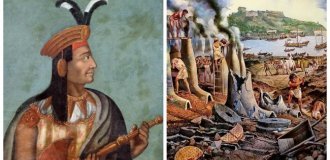Photos of miners (13 photos)
Photographer Vera Salnitskaya went down into the mine named after. November 7 in Leninsk-Kuznetsky and showed people who work at a depth of 300 meters.

You can start working in a mine at the age of 18 after a course of study at a training center or work training courses at enterprises. The first profession with which underground experience begins is an underground miner, or general worker.
The working day of miners looks like this: in the morning they arrive at the administrative and service center of the mine to receive a shift assignment, change into special clothes and receive self-defense equipment. Then they take a bus to the shaft, go down into the mine, then ride diesel trucks through the workings or walk to the working faces.

In the coalfaces themselves, the work shift lasts 6 or 8 hours. Then the miners return to the administrative center, hand over their lamps and self-rescuers to the lamp room, wash themselves and go home. With an 8-hour shift, the week alternates between three working days and three days off. People spend no more than 30 hours a week underground. “As a rule, if in the first 2-3 years a person gets used to the rhythm and conditions of work at a mine, he remains in the profession for a long time,” note the SUEK press service.

There are two main professions in a mine: a longwall miner and a miner. A miner, also known as a miner, extracts coal from a longwall face (longwall). This is one of the highest paid professions in the mine. A miner operates a mechanized complex that extracts coal. The complex consists of a multi-ton shearer (pictured), which uses augers to cut coal from the seam, as well as support sections supporting the roof and a face conveyor, along which the coal cut by the shearer is transported from the face to adjacent workings. The complex is served by a team of 8–12 people per shift.

The miner paves the way into the subsoil, carrying out preparatory mine workings for subsequent mining. This is usually done using special roadheaders (pictured). The tunneling team consists of 3-4 people.

In a modern mine, coal mining is becoming increasingly mechanized and automated. Many operations that used to involve heavy physical labor are now performed by machines controlled by computer programs.

As with many professions that involve risk, miners have many occupational superstitions and folklore. In Bazhov's tales, the Mistress of the Copper Mountain is described, living in the Mountainous Urals and appearing before people either in the form of a beautiful maiden or a lizard in a crown. In the Donbass, Shubin, a mythical mountain spirit with a peculiar sense of humor, is considered an underground brownie.

Once upon a time, a cage with a canary was taken into the mine for a shift. The birds were sensitive to methane and carbon monoxide in the air, which could lead to an explosion. Now the role of canaries is played by automated systems for monitoring the state of the mine atmosphere. Hundreds of sensors are installed in mines and on mechanisms, which are capable of not only signaling danger, but also automatically turning off all operating equipment in the dangerous area.

Perhaps the most famous miner in the former USSR is Alexey Stakhanov. The professional holiday Miner's Day, which is celebrated on the last Sunday in August, is now dedicated to the date of Stakhanov's record. In cities where the mine is a city-forming enterprise, this holiday becomes the main city event.

The average salary of Kuzbass miners is about 43 thousand rubles. The constant component, independent of the plan, is at least 70% of the salary.

Working in a mine requires a lot of self-control, patience, endurance and willpower. It is not suitable for people who are afraid of closed spaces and have lung problems. Miners often suffer from respiratory diseases due to inhalation of coal dust. Health is also affected by noise and vibration, lack of lighting, ventilation and heavy physical labor.

The miners' working week is shorter than usual, and vacation is longer - 56 days a year. Many companies have their own sanatoriums for staff. After 20–25 years, depending on their profession, miners can receive a preferential pension.

The mining profession is mainly chosen by people living in coal-mining regions. Usually the miners themselves say that they love their work because it feeds their families. In small mining towns, working in the coal industry provides relatively high, stable earnings and benefits. As a rule, the enterprises of large coal companies have powerful social programs.






















